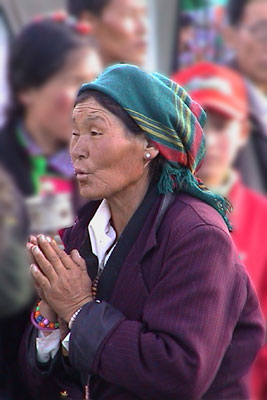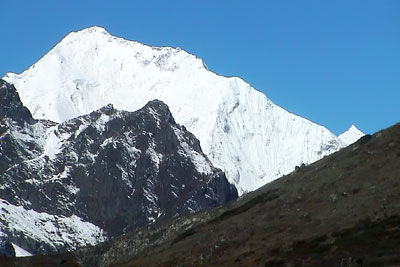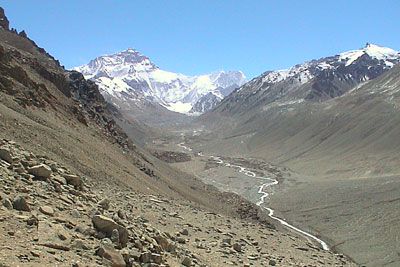
Tibet in 2002
Lhasa and Everest area in Tibet
Chitwan (Nepal)

In Lhasa you always see many pilgrims
Together with Otto from Nepal to Lhasa, by plane, and from Lhasa back to Nepal, by car.
The previous year, during the Annapurna trek, we had been quite pleased with our guide. He had also given us the impression that he could lead a trek to Tibet, on the condition that we booked the trip at his son's office in Kathmandu. We made our bookings as suggested but as it turned out, the son merely had a ticket office and had passed the responsibility for organising our Tibet trip to a genuine trekking agency.
When we complained to him about some problems we had experienced in Tibet, he did not really want to discuss the matter and we had to be quite persuasive before he organized a meeting with the trekking agency concerned.
After arrival in Kathmandu we were put in a plane to Lhasa, where a Chinese travel agent waited for us. I had asked Kame to go along as my personal porter. He speaks Tibetan.
The previous year, during the Annapurna trek, we had been quite pleased with our guide. He had also given us the impression that he could lead a trek to Tibet, on the condition that we booked the trip at his son's office in Kathmandu. We made our bookings as suggested but as it turned out, the son merely had a ticket office and had passed the responsibility for organising our Tibet trip to a genuine trekking agency.
When we complained to him about some problems we had experienced in Tibet, he did not really want to discuss the matter and we had to be quite persuasive before he organized a meeting with the trekking agency concerned.
After arrival in Kathmandu we were put in a plane to Lhasa, where a Chinese travel agent waited for us. I had asked Kame to go along as my personal porter. He speaks Tibetan.
Lhasa is impressive. We also visit some convents in the surrounding area. From experience we know that at a lot of places it is very expensive to get permission to film, but in the Potala, the former palace of the (escaped) Dalai Lama, one is not allowed to film at all. In fact photography is banned too. This is disappointing but has nevertheless a happy outcome, because it is the reason for me to buy a book with splendid photographs and excellent explanatory texts. I could never have taken better pictures myself.
This trek is full of unexpected events. Even before we leave Lhasa our guide is suddenly replaced without any explanation by the trekking agency as to why. Then Kame has a fall in the bathroom of his hotel and bruises a couple of ribs. He fears they may be broken. Still, he goes along to Kharta Qu even though he must be suffering awful pains, especially during the drive on the unsealed road full of stones. After the first day of the trekking it is clear that he really cannot go on. The following morning, he returns to Kharta Qu.

Kangshung face of Everest
Thus, without my personal helper, we enter the Kangshung valley, on our way to the Kangshung Base Camp of Mt Everest. We cross the Sho La (approx. 4900 m.) and will return via the Kangma La (approx. 5300 m.). When we reach Petang Ringmo the guide says: "this is the Base Camp". We respond with: "no, according to our route description the Base Camp is still one day's walking away". The yak herdsmen have already gone further, because one of the yak has walked on and needs to be brought back. Whatever we say, our guide refuses to change his mind. He continues to say that this is the destination his boss has given him. Even the input from trekkers returning from the Base Camp, who confirm our opinion, fail to sway him. It is no consolation that those returning trekkers have not seen the Kangshung face of the Everest because of low clouds. We go no further than about hundred meters above the meadow area at Rabka Chu.
Back in Kharta Qu we drive via Dingri to the Dza Rongphu convent situated about 10 km. before the Everest Base Camp.
Back in Kharta Qu we drive via Dingri to the Dza Rongphu convent situated about 10 km. before the Everest Base Camp.

Everest, as seen from the slope above the Rongbuk monastery.
Here the fun starts again. The guide: "my boss told me to bring you here and after four days we leave and drive to the border with Nepal".
Our reply: "no, according to our itinerary we have eight days here to trek to the Advanced Base Camp for climbing Everest via the North Col Route". For a moment it looks like he agrees to stay for eight days, but then: "no, it remains four days".
Otto hires a yak herd himself to go to the North Col Base Camp in the shortened time available. I have a light headache and dare not ascend another 1000 meters in only two days. Instead I spend the next few days doing shorter walks including one which takes me to approximately two hours behind the Everest Base Camp and another to the slope above Dza Rongphu.
In Zangmu, at the border with Nepal, Otto gives no tip to the Tibetans and I give a very small one. I'm still of the opinion that the head of the trekking agency is mainly to blame for the problems during this trip.
Our reply: "no, according to our itinerary we have eight days here to trek to the Advanced Base Camp for climbing Everest via the North Col Route". For a moment it looks like he agrees to stay for eight days, but then: "no, it remains four days".
Otto hires a yak herd himself to go to the North Col Base Camp in the shortened time available. I have a light headache and dare not ascend another 1000 meters in only two days. Instead I spend the next few days doing shorter walks including one which takes me to approximately two hours behind the Everest Base Camp and another to the slope above Dza Rongphu.
In Zangmu, at the border with Nepal, Otto gives no tip to the Tibetans and I give a very small one. I'm still of the opinion that the head of the trekking agency is mainly to blame for the problems during this trip.
In Kathmandu Otto actually manages to get some compensation in the form of a stay in Chitwan. We conclude our journey with some nice days in the Chitwan Jungle Lodge. This resort is inside the national park, until recently a royal national park.